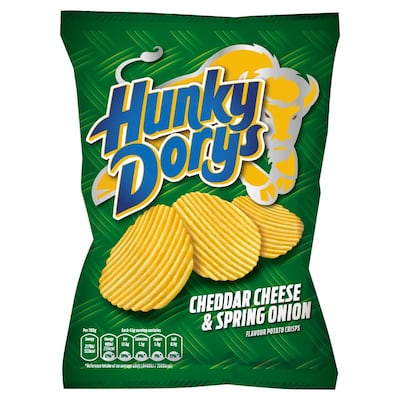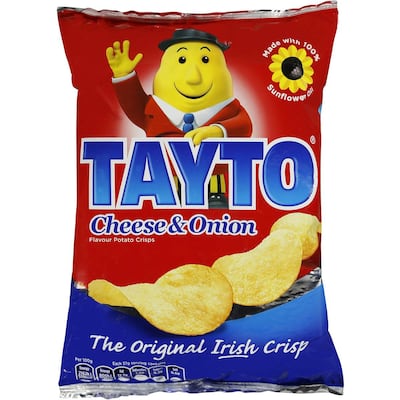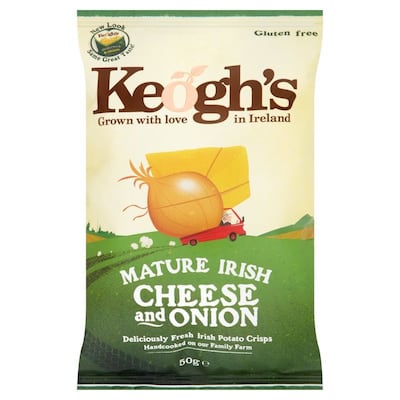Crisps have been popular snacks in Ireland since even before Joe "Spud" Murphy started to sell Tayto in 1954. While Tayto dominates the market here, there are many brands available, from the cheap to the posh. The choice is no longer simply between Tayto and King, which incidentally are both owned by Largo Foods.
So what can you learn from a “package” of cheese and onion crisps?

Firstly, don’t always expect to find any cheese. Hunky Dorys, another Largo brand, makes cheese and onion flavour crinkle cut crisps using potatoes and sunflower oil, but no cheese.
That’s because it uses what is described as a “cheese and onion flavour”, which is made up of onion powder, yeast powder, dextrose (a form of sugar), salt, soya for more flavour and ammonia caramel, an artificial colour. The label also notes that the soya flavouring includes E621, a flavour enhancer also known as monosodium glutamate (MSG). Lastly, these Hunky Dorys have “smoke flavouring” to help remind you of the old days down the pub perhaps. It also says there may be traces of wheat, barley or milk – though no cheese.

Tayto does better in that its “cheese and onion flavour” coating its crisps includes “cheese powder” made from milk. In a strange bit of editing, though, the ingredients list for the “cheese and onion flavour” includes “flavourings”. So the added flavour includes unnamed flavourings.
There is also salt, wheat flour, dextrose, flavour enhancers in the form of E621 (MSG again) and E635, also known as disodium 5’-ribonucleotides. Unfortunately for coeliacs, that wheat means they are off the snack list. Turmeric extract and paprika extract are added for colour.
No good news
Energy value, which means the number of calories or kilojoules, is listed on the front and there is no good news there. Even a small bag at 35g has about 180 calories, which is equivalent to about three apples or two chocolate digestives.
The front of this Tayto cover says, “The original Irish crisp”, but I’d be surprised if these were the ingredients used in the 1950s.
There are far fewer ingredients to be found listed on a packet of King crisps, with just potato, sunflower oil, and cheese and onion flavour. That “flavour” also has flavouring, salt, flavour enhancer (E621) and dextrose. But that’s it. So is it the cheese powder in Tayto that makes it taste different? Or the disodium 5’-ribonucleotides? Or mystery flavourings?

Keogh’s Mature Irish Cheese and Onion crisps are made in north Co Dublin using Irish potatoes, which you can trace back to the individual farm. So the provenance is clear. The Keogh family has been selling its “artisan” crisps since 2011. These are labelled “gluten free” on the front as they use rice flour rather than wheat to make the cheese stick.
And Keogh’s actually lists among its ingredients dried Dubliner cheese alongside vegetarian cheese. It also has milk in various forms: lactose (the sugar in milk), lactic acid and calcium lactate. It also seemed to be the only product that says exactly how much potato is in the packet at 64 per cent and onion at 3 per cent.

The ingredients in O’Donnell’s Mature Irish Cheese and Red Onion crisps are very similar to those of Keoghs, though it does not list percentages for any ingredients. The biggest difference is that O’Donnell uses non-specific, non-artificial “flavourings”.
These two companies also note that their crisps are free from genetically modified ingredients and monosodium glutamate. Having examined the packets from other brands, it now makes sense that the Keogh and the O’Donnell families would want to highlight those facts, though it is unlikely many consumers realise that crisps from some brands in Ireland have MSG.
Pringles are very different and are as natural as they taste. The main ingredient is “dehydrated potatoes”, which is formed into the concave shapes using corn flour. These also have rice flour and wheat starch. In addition to MSG and dextrose, these have more flavour enhancers in the form of disodium guanylate and disodium inosinate, which aid the perception of a savoury flavour.
Of course, crisps are never the healthiest choice of snack as they have been fried at high temperatures in highly refined oils.
The trick is to have them as an occasional treat, rather than a daily indulgence.
FOOD LABELS SERIES
1) Being a successful shopper
2) Bread
3) Milk
4) Cereal
5) Rashers
6) Yoghurt
7) Soup
8) Hummus
9) Pasta sauce
10) Chinese ready meals
11) Frozen chips
12) Chilled fish
13) Egg
14) Chicken Kiev
15) Crisps
16) Mayonnaise
17) Baked beans
18) Tomato ketchup
19) Chocolate digestive biscuits









